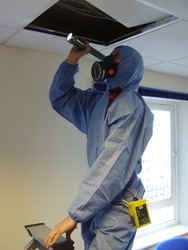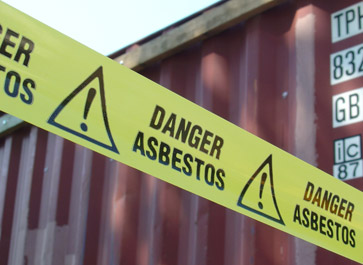Asbestos Removal

Asbestos Removal
M3 Asbestos Ltd
are a fully Licensed Asbestos Removal company.
This licensed
has been held consecutively over 25 years, license no:
4000604426.
With a wealth of
knowledge and experience in the removal, encapsulation and
disposal of all types of Asbestos Containing Materials from
a wide range of locations. Specializing in occupied
industrial/residential buildings and fire damaged
structures.
All operatives
are trained and medically monitored for asbestos.
All Asbestos
contracts are carried out in full conformance with current
statutory requirements.
Removal &
Abatement
Fully Licensed & Insured National and Worldwide Asbestos
removal service.
Specialist works include Asbestos removal and re-insulation
to ships whilst sailing or in dry dock.
We have asbestos
survey and removal contracts not just in the UK but also in
Germany, Italy, USA, Africa and the Middle East.
As a company we carry out contracts around the world on Oil
Rig Installations (both off shore and in dry dock),
Airports, Maritime & Shipping, Health Authorities, Schools,
Construction Sites, and for many Blue chip companies.
Consultancy
Technical and Commercial advice
30 Years + combined professional
experience
Test Applications
-
Asbestos
-
Lead paint
-
Soil
-
Air
-
Water
-
Glazing Identification
-
Anthrax
-
Noise
M3 Asbestos Limited (the Asbestos Removal Company) although
operate an asbestos removal service nationally across the
UK, generally operate in the following region of the south
of England.
Our core main area coverage is in the following towns and
counties:
Aldershot
Hampshire,
Alton Hampshire,
Basingstoke Hampshire, Portsmouth Hampshire, Southampton
in Hampshire.
Banstead
Surrey, Camberley Surrey,
Guildford Surrey, Haslemere Surrey, Reigate
Surrey, Staines Surrey and Woking in
Surrey
Bracknell Berkshire, Reading Berkshire, Newbury Berkshire,
Slough Berkshire, Wokingham in Berkshire
We also specialise in asbestos removal from fire damaged
properties and flood damaged buildings, visit our sister
website by
clicking here to learn more.
Asbestos Surveys
 M3
Asbestos Ltd are specialists in all Asbestos related issues
including being able to identify and test for asbestos
materials within
buildings and maritime.
M3
Asbestos Ltd are specialists in all Asbestos related issues
including being able to identify and test for asbestos
materials within
buildings and maritime.
If your are
suspicious that you may have asbestos within your premises
or just want to be sure, we offer free site surveys.
The duty to
manage Asbestos in non-domestic premises came into force in
May 2004, in which all non-domestic premises are required to
have had an Asbestos Survey. Regulation 4 requires all
Asbestos Containing Materials (ACM’s) present to be
identified and a full Asbestos Register to be in place. This
will assist in the duty to manage the risk of Asbestos
exposure to staff and visitors alike.
HSE and Local Authority Inspectors are already carrying out
prosecutions against companies who are not complying with
Regulation 4. There is no limitation to the fines and HSE
and Local Authority Inspectors will take whatever
enforcement action they deem appropriate based on the
severity of the problem. To avoid the risk of prosecution,
it is imperative that all non-domestic premises have a fully
working strategy, together with an implementation timetable
in place to demonstrate how they are working towards full
compliance with Regulation 4.
M3 Asbestos Limited can undertake every aspect of your
Asbestos Management and ensure your full compliance to the
Control of Asbestos Regulations 2006 (Regulation.
Asbestos
Survey’s fall into three different categories, which one
best suits your needs?
Type 1: Location and assessment survey (presumptive
survey).
The purpose of the survey is to locate, as far as reasonably
practicable, the presence and extent of any suspect Asbestos
Containing Materials in the building and assess their
condition. This survey essentially defers the need to sample
and analyse for Asbestos until a later time. The duty holder
bears potential additional costs of management for some
non-asbestos containing materials. All areas should be
accessed and inspected as far as reasonably practicable.
(e.g. above false ceilings and inside risers, service ducts,
lift shafts etc) or must be presumed to contain Asbestos
until proven different.
Type 2: Standard sampling, identification and assessment
survey (sampling survey)
The purpose and procedures used in this survey are the same
for Type 1, except that representative samples are collected
and analysed for the presents of Asbestos. Samples from each
type of suspected ACM found are collected and analysed to
confirm or refute the surveyor’s judgment. The number of
samples should be sufficient for the surveyor to make an
assessment of whether Asbestos is or is not present.
Sampling is normally carried out simultaneously with the
asbestos survey, or can be carried out as a separate
exercise, after a Type 1 survey has been carried out.
Type 3: Full access sampling and identification survey
(pre-demolition/major refurbishment surveys)
This type of survey is used to locate and describe, as far
as reasonably practicable, all ACM’s in the building and may
involve destructive inspection, as necessary, to gain access
to all areas, including those that may be difficult to
reach. A full sampling programme is undertaken to identify
possible ACM’s and estimates of volume made. The asbestos
survey is designed to be used as a basis for tendering the
removal prior to demolition or major refurbishment.
-
Full
compliance with Regulation 4 of the asbestos regulations
2006
-
All Surveys
carried out in accordance with MDHS 100 and HSG248
-
All our
surveyors are trained to BOHS P402 or higher, with
extensive experience throughout the industry
-
All Asbestos
samples tested by a UKAS accredited laboratory
Learn more,
click below:
Who is
responsible, you or your landlord?
Asbestos
Surveys
Where you will likely find asbestos
What is asbestos?
Click
here
to contact us now to arrange your site survey
[Back
to top of page]
Health and Safety Management for Asbestos
Why manage asbestos?

Asbestos must be properly managed to prevent people dying
from asbestos diseases in the future. Workers who carry out
building maintenance and repair are particularly at risk.
Each year 1000 people who worked in such trades die from
past exposures to asbestos fibres. And these workers are
still at risk.
Half a million commercial buildings still contain asbestos.
If you are responsible for managing the maintenance and
repair of a building, you must manage any asbestos in it.
As well as protecting people from exposure to asbestos
fibres, you have a legal duty to manage asbestos (under
regulation 4 of the Control of Asbestos Regulations 2006).
Following the seven steps to managing asbestos set out below
will help you do this.
Does the duty to manage asbestos affect me?
Yes, if you are responsible for maintenance and repairs. You
are a ‘dutyholder’ if:
-
you own the building;
-
you are responsible through a contract or tenancy
agreement;
-
there is no formal contract or agreement but you have
control of the building;
-
in a
multi-occupied building, you are the owner and have
taken responsibility for maintenance and repairs for the
whole building.
If you are unsure whether
you are a dutyholder - call us and seek our professional
advice.
If you are not
the dutyholder, but have information about the building, you
must
co-operate with the dutyholder, eg landlords must
pass on relevant information to new
tenants, and
leaseholders must allow access for inspection by managing
agents.
What
buildings are affected?
-
All
non-domestic buildings, whatever the type of business.
-
The common
areas of residential rented buildings, eg halls, stair
wells, lift
shafts, roof spaces.
Who is most
likely to disturb asbestos?
Workers who carry out maintenance and repair jobs such as
cutting or drilling into
walls, ceilings or partitions; repairing boilers; laying
cables. Such workers include:
-
construction
and demolition contractors, roofers, electricians,
painters and
decorators, joiners, plumbers, gas fitters, plasterers,
shop fitters, heating and
ventilation engineers, and surveyors;
-
electronics:
phone and information technology engineers, alarm
installers;
-
general
maintenance engineers and others who work on the fabric
of a
building.
Where are
asbestos containing materials (ACMs) likely to be found?
Asbestos can
and will be found in many areas of buildings and our highly
experienced and qualified surveyors know exactly where to
look, but as an indication these are the very common places
to find asbestos:
-
Asbestos
insulation on pipes
-
Asbestos
insulating board ceiling tiles
-
Asbestos
cement panels
-
Sprayed
coatings on walls
-
Asbestos
insulating board panels
-
Textured
coating with asbestos
Asbestos has
been used in many parts of buildings, below is a sample of
uses and locations where asbestos can be found:
|
Asbestos product |
What it
can be used for |
|
Sprayed asbestos (limpet). |
Fire
protection in ducts and to
structural steel work, fire breaks in
ceiling voids etc. |
|
Lagging |
Thermal
insulation of pipes and boilers. Insulating boards.
Fire
protection, thermal insulation, wall partitions,
ducts. |
|
Asbestos cement products |
flat or
corrugated sheets |
|
Roofing and wall cladding |
gutters,
rainwater pipes, water tanks |
|
Certain textured coatings |
Decorative plasters, paints |
|
Asbestos ropes and cloth |
Gaskets,
insulation, seals |
If you
need to have work done:
-
all work
with asbestos must be done by trained people using
proper equipment and deploying proper precautions, don't
risk it, contact us for a professional quotation.
-
you need to
use a licensed contractor to work on high-risk
materials, such as pipe insulation, asbestos insulating
panels or sprayed asbestos.
-
For further
information about Asbestos Removal
click here or call 0800
9776867 (see our contact us for more details);
-
You need PPE
including P3 respirator and disposable overalls to work
on materials such as asbestos cement, textured coatings
or vinyl tile, so don't risk it, contact us for a
professional quotation.
Remember – the duty is all about protecting yourself and
other people from exposure to asbestos fibres by managing
any asbestos present in a building properly. It is not about
removing all asbestos! If the asbestos is in good condition
and not likely to be disturbed, it is usually safer to leave
it in place and manage it.
Removal may be unnecessary and if it is, we will tell you in
our survey and put it in writing to the same effect.
Concentrating
on these seven practical steps should help you comply with
the duty.
More
information is available in the following printable HSE
Manage Asbestos download
here

Information
What is Asbestos?
Asbestos was extensively used as a building material in the
UK from the 1950s through to the mid-1980s. It was used for
a variety of purposes and was ideal for fireproofing and
insulation. Any building built before 2000 (houses,
factories, offices, schools, hospitals etc) can contain
asbestos. Asbestos materials in good condition are safe
unless asbestos fibres become airborne, which happens when
materials are damaged.
Why is Asbestos so dangerous?
Asbestos fibres are present in the
environment in Great Britain so people are
exposed to very low levels of fibres.
However, a key factor in the risk of
developing an asbestos-related disease is
the total number of fibres breathed in.
Working on or near damaged
asbestos-containing materials or breathing
in high levels of asbestos fibres, which may
be many hundreds of times that of
environmental levels could increase your
chances of getting an asbestos-related
disease.
When these fibres are inhaled they can
cause serious diseases which are responsible
for around 4000 deaths a year. There are
three main diseases caused by asbestos:
mesothelioma (which is always fatal), lung
cancer (almost always fatal) and asbestosis
(not always fatal, but it can be very
debilitating).
Remember, these diseases will not affect
you immediately but later on in life, so
there is a need for you to protect yourself
now to prevent you contracting an
asbestos-related disease in the future. It
is also important to remember that people
who smoke and are also exposed to asbestos
fibres are at a much greater risk of
developing lung cancer.
Read more about
what Asbestos is and its dangers here
Did you know that
every week...
3 plumbers die
20 tradesmen die
6 electricians die
6 joiners die
...all
from this hidden killer.
'